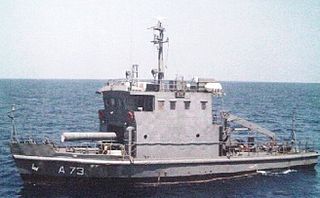
Garden Reach Shipbuilders & Engineers Ltd, abbreviated as GRSE, is one of India's leading shipyards, located in Kolkata. It builds and repairs commercial and naval vessels. GRSE also exports the ships that the company builds.

The Car Nicobar class of high-speed offshore patrol vessels are built by Garden Reach Shipbuilders and Engineers (GRSE) for the Indian Navy. The vessels are designed as a cost-effective platform for patrol, anti-piracy and rescue operations in India's exclusive economic zone. In 2023, one of the ships, INS Tarmugli, was donated to the Maldivian Coast Guard.

The Makar-class survey catamarans are a series of six 500 ton steel hull/aluminium superstructure Hydrographic Survey Catamarans being built by Alcock Ashdown (Gujarat) Ltd at its Bhavnagar shipyard for the Indian Navy. The ships are designed by an Australian naval architecture firm Sea Transport Solutions, which is based on Queensland's Gold Coast. The deal was canceled due to the extensive delays as the Navy was not satisfied with the timeline and a fresh award for construction of another class of survey vessels to the GRSE has also been undertaken.
INS Pamba is a self-propelled water carrier barge built by Vipul Shipyard Ltd in Surat, Gujarat for the Indian Navy.
INS Purak is a self-propelled fuel carrier barge built by Modest Infrastructure Ltd in Bhavnagar, Gujarat, for the Indian Navy.
The Arga class of tugboats are a series of six service watercraft being built by Tebma Shipyard Limited in Malpe, for the Indian Navy.
INS Pulakesin-1 is a self-propelled water carrier barge built by Vipul Shipyard Ltd. in Surat, Gujarat for the Indian Navy. It is named of King Pulakeshin I of the Chalukya dynasty.
The Bhim class of tugboats is a class of service watercraft built by Tebma Shipyard Limited, a subsidiary of Bharati Shipyard Ltd, for the Indian Navy.

INS Gaj is an offshore tugboat built by Hindustan Shipyard Limited, Visakhapatnam for the Indian Navy. It operated under the navy's Eastern Naval Command.
INS Ambuda was a self-propelled water carrier barge built by M/s Garden Reach Workshops Ltd, Kolkata, for Indian Navy.
Shalimar-class ferry is a series of three service watercraft built by Shalimar Works (1980) Ltd, Kolkata for the Indian Navy. The catamarans can carry up to 50 personnel. Each unit in this class is of double-hull catamaran-type and are made of steel.
INS Poshak is a self-propelled fuel carrier barge built by M/s Shalimar Works, Kolkata for the Indian Navy.
The Hooghly-class of fuel barge is a series of service watercraft being built by Hooghly Dock & Port Engineers Ltd, Kolkata (HDPEL) for the Indian Navy.
Corporated-class of sullage barges are a series of seven yard craft being built by M/s Corporated Shipyard Private Limited, Kolkata for the Indian navy.
Vipul class of barges are a series of five self-propelled water carrier watercraft being built by Vipul shipyard, Surat for the Indian Navy.
The Modest class of barges is a series of self-propelled fuel carrier watercraft being built by Modest Infrastructure Ltd in Bhavnagar, Gujarat, for the Indian Navy.

The Astravahini class of torpedo recovery vessels are a series of naval auxiliary watercraft built by Goa Shipyard Limited and P.S. & Company for the Indian Navy. They are intended to recover practice torpedoes and mines, fired and laid by ships, submarines and aircraft. The vessels can stow two full-sized torpedoes on deck and two on a recovery ramp.
Puran class of barge is a series of self-propelled fuel carrier built by Rajabagan Dockyard (RBD) for the Indian Navy.

The Type B ship is a United States Maritime Administration (MARAD) designation for World War II barges. Barges are very low cost to build, operate and move. Barges were needed to move large bulky cargo. A tug boat, some classed as Type V ships, could move a barge, then depart and move on to the next task. That meant the barge did not have to be rushed to be unloaded or loaded. Toward the end of World War 2, some ships that had not been completed in time for the war were converted to barges. US Navy barges are given the prefix: YWN or YW. Due to shortage of steel during World War II, concrete ship constructors were given contracts to build concrete barges, with ferrocement and given the prefix YO, YOG, YOGN. Built in 1944 and 1945, some were named after chemical elements.





